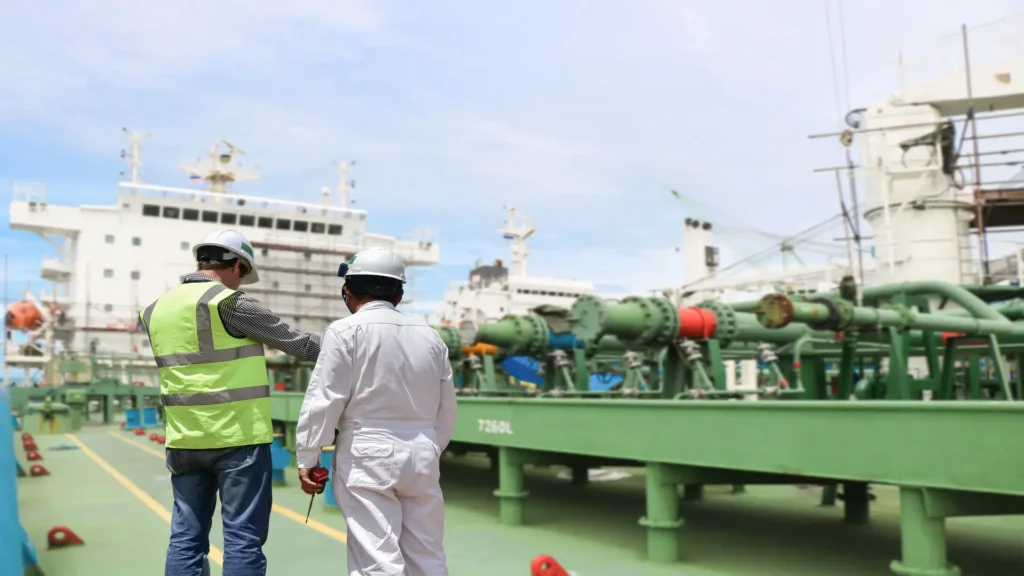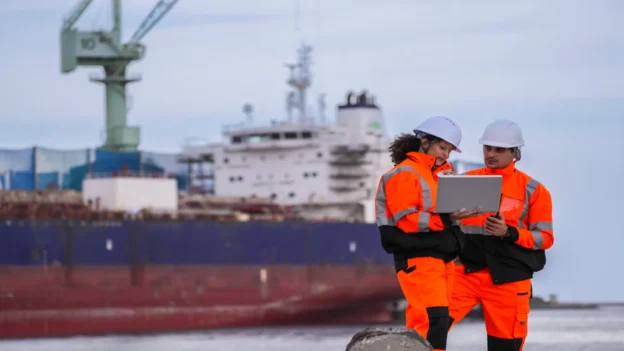Table of Contents
- What does Zero Harm mean in the maritime sector?
- Principles of the Zero Harm approach
- The Zero Harm innovation partners program by rightShip
- Application of Zero Harm in maritime management
- How to Implement the Zero Harm Approach in a Fleet?
- Benefits of Zero Harm and Safety Leadership Training
- Why is it important to adopt the Zero Harm model?
- RightShip Zero Harm Innovation Partners Program
- Technological solutions for real challenges
- International recognition: Partnership with RightShip
- Conclusions
- References
Zero Harm is a risk management approach that seeks the total elimination of harm to people and the environment, considering it a fundamental organizational value. This standard goes beyond mere incident reduction and requires a comprehensive commitment to safety culture, systematic risk analysis, regulatory compliance, and the promotion of safe and reliable operations.
What does Zero Harm mean in the maritime sector?
In the maritime industry, Zero Harm represents the aspiration to operate under a scheme where every process is designed to prevent incidents. Its scope goes beyond regulatory compliance, due to the adoption of a continuous improvement philosophy, a shared safety culture, and organizational accountability.
This implies that every vessel, every maneuver, and every logistical process is evaluated from a holistic risk perspective, integrating the human factor, technical systems, the vessel’s condition, and the operational environment. Below is an image representing maintenance task planning.

Zero Harm starts from a clear premise: incidents are not inevitable. With adequate information, prepared leadership, and a solid culture, it is possible to anticipate risks and significantly reduce them.
Principles of the Zero Harm approach
The approach developed by RightShip is based on four principles.
- The first is proactive prevention: Focused on identifying and mitigating risks before they evolve into an incident, which requires greater use of operational data, predictive analysis, and constant monitoring of conditions onboard and onshore.
- The second is RightShip Safety Leadership: It holds that leaders’ behavior directly influences the culture of a fleet. A captain, chief engineer, or superintendent who makes decisions aligned with Zero Harm can transform how an entire crew perceives safety.
- The third is shared responsibility: Zero Harm does not rely on an isolated safety department but involves the entire maritime chain. Operators, crew, suppliers, inspectors, and administrators must take an active role in risk identification and reporting.
- Finally, the fourth principle is continuous learning: Every operation, inspection, near-miss, or report constitutes an opportunity for improvement. The Zero Harm approach promotes a system where feedback is constant, and lessons learned are rapidly integrated into procedures.
The Zero Harm innovation partners program by rightShip
RightShip consolidated its safety vision through the Zero Harm Innovation Partners Program, a global initiative that brings together companies committed to raising safety standards beyond the regulatory minimum.
This program functions as a collaborative platform where partners share data, validate new technologies, drive pilot projects, and adopt modern risk assessment methods. The program encourages the development of advanced digital solutions, new performance metrics, and monitoring tools that allow anticipating hazardous behaviors, improving operational planning, and reinforcing crew well-being.
Through this ecosystem, RightShip seeks to accelerate the transition toward a truly safe and sustainable navigation model. The following video presents an introduction to RightShip safety, courtesy of RightShip.com.

Introduction to RightShip security.
Application of Zero Harm in maritime management
Applying Zero Harm in the daily operation of a fleet implies bringing its principles to real processes occurring onboard and onshore. This includes incorporating predictive assessments using platforms like RightShip Qi, conducting performance-centered audits rather than merely document compliance, and integrating technologies capable of monitoring operational conditions in real time.
Maritime management under this approach is also strengthened when crew well-being is prioritized. Fatigue, workload, and stress are factors that can lead to severe incidents, and Zero Harm promotes more rigorous and human-centered monitoring of these indicators. Likewise, the optimization of maneuvers, routes, cargo transfer operations, and port-vessel coordination is carried out considering how to minimize the possibility of errors.
How to Implement the Zero Harm Approach in a Fleet?
Adopting the Zero Harm model is generally developed in four phases.
- The first is the initial assessment, where a comprehensive diagnosis of safety performance, organizational culture, historical incidents, and existing operational gaps is conducted.
- The second phase involves integrating Zero Harm procedures into operational manuals and work routines. This includes updating metrics, redefining responsibilities, and establishing more effective reporting and analysis mechanisms.
- The third stage is linked to leadership development and training. Here, the Zero Harm Safety Leadership Training is especially relevant, a program aimed at strengthening decision-making, communication, and human factor management skills. This training transforms the Zero Harm philosophy into behaviors applicable in real navigation and operational environments.
- The fourth and final phase focuses on monitoring and continuous improvement. Performance metrics, incident analyses, and crew feedback allow adjusting the system and consolidating it as an operational standard within the fleet.
Benefits of Zero Harm and Safety Leadership Training
Fleets that implement the Zero Harm model observe a notable reduction in personal, material, and environmental incidents. Additionally, increased operational reliability favors vessel availability, reduces costs associated with failures and interruptions, and strengthens corporate reputation with clients, insurers, and port authorities.
Safety Leadership Training, in turn, provides leaders with concrete skills to manage teams, promote safe behaviors, and anticipate risks. This training becomes the bridge that translates Zero Harm theory into daily onboard practice.
Why is it important to adopt the Zero Harm model?
The evolution of the maritime industry demands new safety models capable of responding to 21st-century challenges. Zero Harm positions itself as an effective response that combines technology, leadership, data, and organizational culture to achieve higher levels of performance.
Implementing it not only improves safety but also increases efficiency, protects the environment, enhances competitiveness, and strengthens the future of maritime operations. In a sector where every decision impacts lives, assets, and ecosystems, Zero Harm becomes an indispensable standard for those seeking to operate with excellence.
RightShip Zero Harm Innovation Partners Program
The maritime industry is experiencing a period of accelerated transformation. Increasing vessel sizes, route complexity, regulatory requirements, and the pressure to operate more sustainably have made traditional safety models insufficient.
Maritime Trainer: Digitalization at the service of maritime safety
In a sector where operational safety and the human factor determine the success of each voyage, Maritime Trainer has established itself as an international reference in digital learning solutions and competency management for the maritime industry.
Since its founding in 2011, the company has demonstrated that strategically applied technology can revolutionize the way maritime talent is trained, assessed, and retained.
Maritime Trainer, leader in maritime training
With more than 50,000 trained seafarers and presence on 1,000 vessels worldwide, Maritime Trainer has built a training ecosystem that addresses the sector’s most critical needs.
Its philosophy “Assess, Train, Retain” is not just a slogan: it is a proven operational model that reduces human error, strengthens regulatory compliance, and substantially improves crew well-being.
Technological solutions for real challenges
Maritime Trainer addresses the three fundamental pillars of modern maritime operations:
- Reducing human error: Through competency-based assessments and immersive training, the platform identifies knowledge gaps before they result in incidents.
- Crew well-being and retention: Through proactive management of mental health and fatigue, the company recognizes that motivated and healthy crews are the foundation of safe operations.
- Comprehensive regulatory compliance: These tools ensure adherence to international safety and environmental standards, facilitating audits and certifications.
International recognition: Partnership with RightShip
Maritime Trainer’s recent inclusion in RightShip’s prestigious Zero Harm Innovation Partners Program validates its position as a trusted innovator. This strategic alliance with one of the most respected maritime inspection and assessment organizations confirms that Maritime Trainer not only meets the highest industry standards but is actively helping define them. The collaboration aims to eliminate harm in the global maritime sector through the adoption of best practices in training, well-being, and operational safety.
Future vision: AI at the service of navigation
Maritime Trainer does not stop at current achievements. The company is developing AI-driven solutions that promise to revolutionize regulatory compliance, onboard decision-making, and incident prevention. These emerging technologies will be strategically integrated as they mature, ensuring effective and measurable implementation.
Strategic partner in specialized technical content
For web platforms specialized in maritime technical content, Maritime Trainer represents an exceptional source of updated knowledge, real case studies, and technology trends validated by thousands of active users. Its proven expertise in:
- Adaptive digital training.
- Nautical competency management.
- Crew well-being technologies.
- International regulatory compliance.
- Operational safety innovation.
Conclusions
Adopting Zero Harm allows shipping companies to implement a comprehensive safety approach that combines personnel protection, asset integrity, and environmental care, strengthening organizational culture and promoting preventive decision-making in all maritime operations. This philosophy establishes a clear framework for identifying risks, reducing incidents, and ensuring that every activity is executed with safety and sustainability criteria, becoming a central operational principle.
Implementing Zero Harm directly contributes to more reliable and sustainable operations, ensuring that procedures, training, and technology work together to minimize risks. This approach not only protects crew and material resources but also sets a global standard for maritime risk management, guiding the industry toward more responsible, efficient practices aligned with safety and environmental performance goals.
References
- Kretschmann, L. (2020). Leading indicators and maritime safety: Predicting future risk with a machine learning approach. Journal of Shipping and Trade, 5(19). https://doi.org/10.1186/s41072-020-00071-1 SpringerOpen
- Schröder‑Hinrichs, J.-U., Hebbar, A. A., & Alamoush, A. S. (2020). Maritime Risk Research and Its Uptake in Policymaking: A Case Study of the Baltic Sea Region. Journal of Marine Science and Engineering, 8(10), 742. https://doi.org/10.3390/jmse8100742


